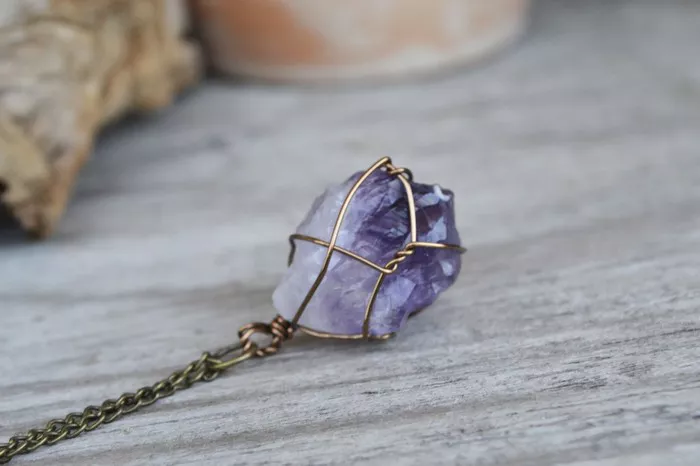Jewelry lovers often marvel at the diverse colors and patterns found in gemstones. Among the most captivating pairs is amethyst and white quartz. While both belong to the quartz family, their striking color contrast captivates the eyes and piques the curiosity of many. This article aims to provide a detailed introduction to these two gemstones, unraveling the secrets behind their color difference through a logical, popular science approach.
Introduction to Quartz
Quartz: The Versatile Gemstone Family
Quartz is a silicon dioxide mineral that occurs naturally in a variety of colors, textures, and forms. It is one of the most abundant minerals on Earth, found in igneous, metamorphic, and sedimentary rocks. Quartz’s versatility and abundance make it a popular choice for jewelry, sculptures, and other decorative items.
Quartz’s Physical Properties
Quartz has a hardness of 7 on the Mohs scale, making it durable and scratch-resistant. Its glassy luster and ability to form large, clear crystals enhance its appeal. Quartz crystals can grow in various shapes, including tabular, prismatic, and nodular forms. The mineral’s physical properties, combined with its beauty, make it a highly valued gemstone.
The Enigmatic Amethyst
Amethyst: The Purple Gemstone
Amethyst is a variety of quartz that exhibits a range of purple hues, from light lavender to deep indigo. Its name is derived from the Greek word “amethystos,” meaning “not drunk,” due to ancient beliefs that the gemstone could prevent intoxication. Amethyst’s popularity has persisted throughout history, and it has been used in jewelry, decorative objects, and religious artifacts.
The Color Secret of Amethyst
The purple coloration of amethyst is due to trace amounts of iron and aluminum impurities within the quartz crystal structure. These impurities absorb specific wavelengths of light, resulting in the absorption spectrum that gives amethyst its distinctive purple hues.
Formation and Occurrence
Amethyst forms in igneous and metamorphic rocks, particularly in pegmatites and geodes. It can also be found in cavities within volcanic rocks and lava flows. The mineral’s purple hue is often enhanced by heat treatment, a process that removes any unwanted coloration and intensifies the purple tones.
Amethyst’s Healing Properties
Beyond its aesthetic appeal, amethyst is also believed to have healing properties. According to ayurvedic medical practitioners and crystal healers, amethyst is a powerful gemstone that can heal the body and mind. It is believed to promote relaxation, reduce stress, and enhance spiritual awareness. These beliefs add to the gemstone’s mystical charm and make it a popular choice for those seeking spiritual growth or simply a meaningful accessory.
The Pure White Quartz
White Quartz: The Crystal-Clear Gemstone
White quartz, also known as clear quartz, is a variety of quartz that lacks coloration. Its transparent appearance allows light to pass through, giving it a glassy luster and a sense of clarity. White quartz is one of the most common types of quartz and is found worldwide.
The Lack of Color
The absence of color in white quartz is due to the absence of impurities within the crystal structure. Unlike amethyst, which owes its purple hue to iron and aluminum impurities, white quartz has a relatively pure silicon dioxide composition. This purity makes white quartz a highly valued gemstone for jewelry and decorative purposes.
Formation and Occurrence
White quartz forms in a variety of geological settings, including igneous, metamorphic, and sedimentary rocks. It can occur as large, clear crystals or in massive, granular forms. The mineral’s clear appearance and durability make it a popular choice for jewelry, sculptures, and other decorative items.
Unraveling the Color Difference
Chemical Composition and Impurities
The primary reason for the color difference between amethyst and white quartz lies in their chemical composition and impurities. As mentioned earlier, amethyst owes its purple hue to trace amounts of iron and aluminum within the quartz crystal structure. These impurities absorb specific wavelengths of light, resulting in the absorption spectrum that gives amethyst its distinctive purple hues.
In contrast, white quartz lacks these impurities, resulting in a clear, transparent appearance. The purity of the silicon dioxide composition allows light to pass through without absorption, giving white quartz its glassy luster and clarity.
Formation Conditions
The formation conditions of amethyst and white quartz can also contribute to their color difference. Amethyst often forms in igneous and metamorphic rocks, particularly in pegmatites and geodes, where high temperatures and pressures can alter the crystal structure and introduce impurities.
White quartz, on the other hand, can form in a variety of geological settings, including igneous, metamorphic, and sedimentary rocks. Its ability to form in a wide range of conditions allows it to maintain its purity and clear appearance.
Optical Properties
The optical properties of amethyst and white quartz also contribute to their color difference. Amethyst’s purple hue is due to the absorption of specific wavelengths of light by the impurities within the crystal structure. This absorption results in the reflection of purple light, giving the gemstone its distinctive color.
In contrast, white quartz allows all wavelengths of light to pass through, resulting in a clear, transparent appearance. This clarity makes white quartz a popular choice for jewelry and decorative items that require a sense of transparency and purity.
Conclusion
In conclusion, the color difference between amethyst and white quartz lies in their chemical composition, formation conditions, and optical properties. Amethyst’s purple hue is due to trace amounts of iron and aluminum impurities within the quartz crystal structure, while white quartz lacks these impurities, resulting in a clear, transparent appearance.
Related topic:
- How to Charge an Amethyst Necklace?
- How to Tell if an Amethyst Necklace is Real
- How to Obtain the Braxton Amethyst Necklace


